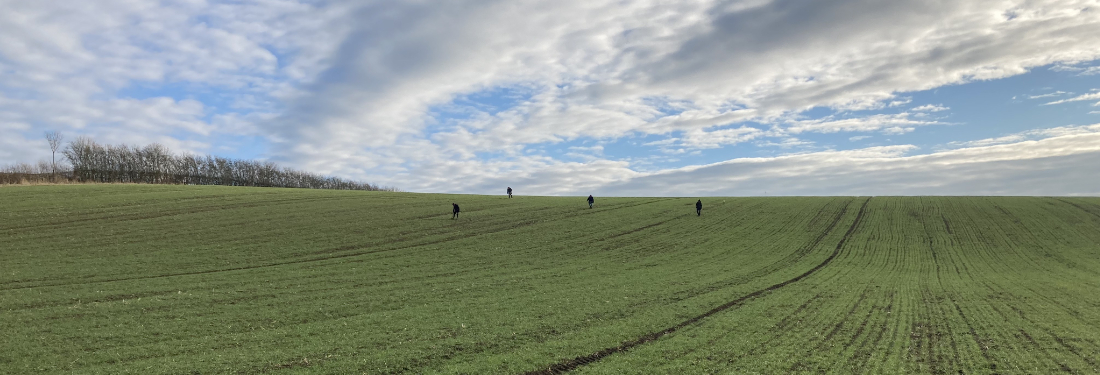How an IT project manager helped the National Trust plant 90,000 trees

What would you choose to do on a gap year from work? Hit the beach, write a book, learn to sail? How about help plant 90,000 trees?
Project Manager Jason Sellars chose the latter when, on a year’s break from managing mega IT projects for the banking and insurance sector in Canada, he helped lead the National Trust’s largest ever tree-planting project at the Wimpole Estate, Cambridgeshire.
It took a year for the trees to be planted on the 2,471-acre site as the Trust ramps up its efforts to meet its 2030 net-zero carbon target.
Although not strictly on a gap year, Sellars, who said he was looking for “something different” during a year-long sojourn in the UK, was instantly attracted to the project.
“I’ve had a 16-year career in financial technology project delivery and sometimes it is difficult to always see the benefits of what you are doing,” he says. “When I was asked to help deliver a project which would directly help the climate, it was a no-brainer.”
An ultra-compressed timeline
Apart from trying to combat global warming, the 14 species of native trees that were planted – including oak, hornbeam, wild cherry, field maple and birch – and the 10 species of shrub, including hazel, will also build resilience into the landscape, given the growing number of tree diseases.
Despite these exciting and important goals, the challenge was clear from the outset of the project, which had to be completed in a year.
“Planting that number of trees is usually a two- or three-year job, so it was a tight timeline,” explains Sellars. “The planting also had to be carried out on what was at the time reasonably poor agricultural land. In addition, we were tasked to deliver a number of school and community engagement opportunities and help boost local employment. There was a wide range of deliverables and, as such, the scope was quite wide.”
Sellars started his role last April – two months after the scheme was launched – with the first key task being to determine where on the estate the trees should be planted. Another early aim was to start engaging with stakeholders and understand their requirements.
That included developing a partnership with the Woodland Trust, which helped Sellars determine which species of tree and shrub should go where and to set out the planting plan.
However, the literal unearthing of the unexpected often got in the way. “In the IT world, nobody is ever going to tell you that you can’t do something because someone thinks they have found a Roman villa,” he says. “There was a significant amount of archaeology in some of the fields we wanted to plant trees on. We did a lot of magnetometer work to make sure we could plant there.”
In addition, key stakeholder the Royal Society for the Protection of Birds advised Sellars of certain areas where planting trees could have an adverse effect on rare farmland bird species, such as the corn bunting. Other stakeholders included Natural England, who advised on issues that could affect the existing habitat.
“We also had to look at the financial implications of taking farmland out of production,” he adds. “These were issues that needed to be addressed, so they were a challenge. But I also found the flavour of them interesting.”
Wellies on for weekly catch-ups
Sellars and his dedicated seven-strong team also had to work closely with Wimpole’s visitor engagement and countryside management teams. “Overall, it was a very disparate team with some at home, some in the office and some on the estate. The countryside rangers were out in the fields and if I wanted to go and see them, I had to put on my wellies and go out and find them! That made daily or weekly catch-up meetings a bit trickier than in an IT department. You had to tailor them around the individuals and how they worked.”
After deciding which trees would go where, the next task was to source them.
“Normally, you would give nurseries lead times of two years to give them an opportunity to build up stock,” he says. “We rocked up and said we needed 90,000 in two months! You can imagine those conversations, especially when everyone seems to be planting trees at the moment.”
The key to securing the supply was leveraging the partnership with the Woodland Trust. “They have a great relationship with nurseries and without that we may have struggled,” Sellars explains.
The next task was to split the planting up into three areas. The first was woodland creation, requiring a high density of trees; the second was woodland pasture, groups of trees in a field that would be grassed over and used by livestock; and the third was agro-forestry, which combined the apple trees and arable farming.
“We hired an experienced planting crew for the woodland and agro-forestry work, and for the pasture we used the ranger team and about 40 local volunteers,” Sellars explains. “So, after 10 months of planning we started planting last December and finished in early March. We were lucky with the weather, but everyone worked together well and happily. We are so chuffed to do it in such a short time.”
Stepping out of your comfort zone
Now the trees are in the ground, the National Trust will wait between three and five years before introducing livestock. It also hopes to earn an income from the apple trees.
Sellars, however, is tearing up his newly discovered English roots and returning to Canada. “I’m going back to banking and finance. But this was a personal journey which professionally delivered great outcomes,” he says. “It really shows the value of stepping out of your normal environment and it has revitalised the spark of delivery in me. Maybe other project managers should try it!”
Image: Volunteers from the Cambridge Archaeological Field Group, field walking at Wimpole. Credit Susanne Thompson
You may also be interested in:


0 comments
Log in to post a comment, or create an account if you don't have one already.